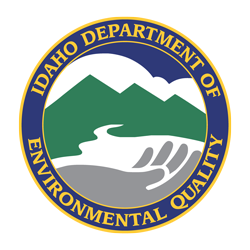Author: Anna Marron
DEQ seeks representative for Middle Snake Watershed Advisory Group
TWIN FALLS — The Idaho Department of Environmental Quality (DEQ) is seeking a municipal representative to serve as a voting member on the Middle Snake Watershed Advisory Group (WAG).
Read Full ArticleDEQ accepting applications for Twin Falls Woodstove Changeout Program
TWIN FALLS — The Idaho Department of Environmental Quality (DEQ) is accepting applications for the Twin Falls Woodstove Changeout Program.
Read Full ArticleDEQ announces $220,000 in grant funding to support sustainable materials management projects
BOISE —The Idaho Department of Environmental Quality (DEQ) is seeking project proposals that enhance or support innovative waste reduction or prevention.
Read Full ArticleDEQ seeks comment on draft IPDES permit for the Idaho Wildlife and Water Quality Group Mason Creek Activated Wetland Pilot Project
BOISE – The Idaho Department of Environmental Quality (DEQ) seeks comment on a draft Idaho Pollutant Discharge Elimination System (IPDES) permit for the Mason Creek Activated Wetland Pilot Project.
Read Full ArticleAdditional tests reveal low levels of cyanotoxins in lake bottom material at North Beach in Payette Lake
VALLEY COUNTY — The Idaho Department of Environmental Quality (DEQ) is urging caution after national lab tests revealed the presence of cyanotoxins in material in the lakebed of North Beach.
Read Full ArticleCoeur d’Alene Lake Advisory Committee announces open solicitation for projects that reduce phosphorus runoff
COEUR D’ALENE—Governor Little’s Coeur d’Alene Lake Advisory Committee announced Tuesday that the solicitation period for submitting nutrient-reduction proposals is now open.
Read Full ArticleCommittee begins process of reversing phosphorus trends in Coeur d’Alene Lake
COEUR D’ALENE — The Coeur d’Alene Lake Advisory Committee (CLAC) convened for the first time Thursday to examine strategies for reducing phosphorous pollution in North Idaho’s iconic water body.
Read Full ArticleDEQ expands statewide cyanobacteria and cyanotoxin response efforts
BOISE — The Idaho Department of Environmental Quality (DEQ) is expanding sampling and monitoring efforts across the state to enhance public preparedness and heighten bloom detection.
Read Full ArticleDEQ awards $45,000 to the city of East Hope in Bonner County
BOISE — The Idaho Department of Environmental Quality (DEQ) today announced the award of a $45,000 drinking water construction assistance to the city of East Hope in Bonner County.
Read Full ArticleDEQ awards $4.32 million to the Panhandle Village Water System in Kootenai County
BOISE — The Idaho Department of Environmental Quality (DEQ) today announced the award of a $4.32 million low-interest drinking water construction loan to the Panhandle Village Water System, Kootenai County.
Read Full ArticleDEQ seeks comment on proposed plan to lower lead and zinc in the Upper Spokane River Watershed
Coeur d’Alene — The Idaho Department of Environmental Quality (DEQ) seeks comment on a proposed plan to address elevated levels of lead and zinc in the Upper Spokane River Watershed.
Read Full ArticleDEQ awards $1.65 million drinking water construction loan to the city of Priest River
BOISE — The Idaho Department of Environmental Quality (DEQ) today announced the award of a $1.65 million low-interest drinking water construction loan to the city of Priest River in Bonner County.
Read Full ArticleDEQ awards wastewater planning grant to the city of Lewisville
BOISE — The Idaho Department of Environmental Quality (DEQ) today announced the award of a wastewater planning grant for $25,000 to the city of Lewisville in Jefferson County.
Read Full Article

